STS Software GmbH - Top Agile Softwareentwicklungsfirma in der Schweiz
Schweiz ist eines der europäischen Länder mit einer ungleichen Marktdynamik von IT-Talenten. Mitteleuropa bietet eine unglaubliche Liste von Softwareentwicklungsunternehmen, die eine Vielzahl von einheimischen Softwareentwicklern sowie leidenschaftliche Ingenieure aus anderen potenziellen Nationen angezogen hat
Als Oltner Unternehmen verfügt die STS Software GmbH über eine starke Truppe von
Software-Ingenieuren. Mit dieser Verstärkung hat das Team der STS Software GmbH eine Vielzahl von namhaften Schweizer Unternehmen als strategische Partner erreicht, was zu unserer bereits beachtlichen Branchenposition beiträgt.
Du brauchst:
- Brauchen Sie eine einmalige Anwendung, die für Sie entwickelt wird?
- Gibt es ein bestehendes Projekt, das verbessert und gewartet werden muss?
- Oder ein Projekt, das übernommen wurde, um eine Vielzahl von verwandten Merkmalen und Funktionen zu erweitern?

Oder ein Projekt, das übernommen wurde, um eine Vielzahl von verwandten Merkmalen und Funktionen zu erweitern?
Über uns
Wer wir sind
Wenn Unternehmen in der Schweiz einen Mangel an Softwareentwicklern haben, helfen wir ihnen mit Outsourcing-Dienstleistungen für die Softwareentwicklung. Wir versprechen eine prompte und qualitativ hochwertige Auftragsabwicklung. Letztlich verpflichtet sich unser Team, die Kosten für die Softwareentwicklung so weit wie möglich zu senken, ohne dabei die Qualität zu gefährden.
Die Mitarbeiter der STS Software GmbH sprechen Englisch, arbeiten aber dennoch gut mit Kunden und Partnern in Regionen von Asien bis zu den Vereinigten Staaten zusammen. Wir sind ein zukunftsorientiertes Softwareentwicklungsunternehmen, das modernste Systeme einsetzt, um die digitalen Marketingbemühungen unserer Kunden zu maximieren. Wir versprechen eine prompte und qualitativ hochwertige Auftragsabwicklung. Letztlich verpflichten wir uns, die Kosten für die Softwareentwicklung so weit wie möglich zu senken, ohne dabei die Qualität zu gefährden.
UNSERE DIENSTLEISTUNGEN?
Was wir tun
Wir verwenden eine breite Palette von Programmiersprachen wie Java, C#, C++, Python usw. Wir erstellen maßgeschneiderte und benutzerfreundliche mobile Apps, die das Kundenerlebnis verbessern und die Sichtbarkeit der Marke unserer Kunden erhöhen.
Unsere hauseigenen Software-Ingenieure verfügen zusätzlich zu ihrem Fachwissen in der Entwicklung kundenspezifischer Software über umfangreiche Erfahrung mit einer Vielzahl von Web-/Mobile-App-Plattformen.
Warum wir
Wie wir es machen
Designorientiertes Engineering
Wir verwenden eine designorientierte Strategie, um die Benutzererfahrung des Kunden drastisch zu verändern und ansprechende Mobil- und Weblösungen zu entwickeln.
Flexibles Engagement
Unsere Beratungs- und Kundenbindungsdienste ermöglichen es uns, einen kontinuierlichen Kontakt während des gesamten Projekts zu gewährleisten, was zu einem größeren Wert und langfristigen Verbindungen führt.
Erschwinglicher, kosteneffizienter Ansatz
Wir verfolgen einen kooperativen und flexiblen Ansatz bei der Bewältigung von Geschäftsproblemen. Der wichtigste Aspekt unserer Dienstleistungen ist, dass wir höchste Qualität liefern und gleichzeitig Ihrem Unternehmen Zeit und Geld sparen.
Vertrauenswürdige Sicherheitsprotokolle
Cybersicherheit ist eine Priorität für jedes moderne Projekt. Wir befolgen stets die neuesten Sicherheitsprotokolle, um Ihre Daten und Softwareprodukte zu schützen.
Progressiver Fahrplan
Wir sind stolz darauf, ein ergebnisorientiertes Unternehmen zu sein, das sich die Zeit nimmt, das einzigartige Projekt eines jeden Kunden kennenzulernen und maßgeschneiderte Lösungen anzubieten.
Methodik des gesamten Zyklus
We deliver the the full software development lifecycle, including requirements, development, testing, deployment, and operations. Erhalten ein kostenloses Angebot
Methoden
Wie wir es machen

Prototyping
We help our clients and their end-users visualise the look-and-feel and interaction of the finished product before it is actually built using state-of-the-art design and prototyping tools.
Agiler Entwicklungsansatz
Wir verwenden den agilen Entwicklungsstil neben den traditionellen Ansätzen, um die Zuverlässigkeit des Lieferplans und die Qualität des Endprodukts zu gewährleisten. Dies ist auch die Methodik, die die STS Software GmbH verfolgt.
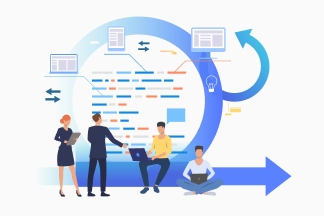
Agile Development
We use agile development style alongside the traditional approaches to ensure reliability of delivery schedule and quality of the end product.

Software Specifications
Wir schreiben ein Software-Spezifikationsdokument (Software Blueprint), um sicherzustellen, dass unsere Kunden genau das bekommen, was sie erwartet und vereinbart haben – in Bezug auf die Funktionalität und das UI- und UX-Design des Produkts.
Unsere Kunden
Vertrauenswürdig von



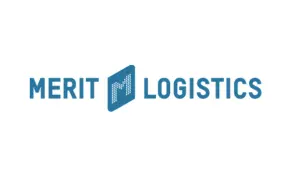




Blogs
Was wir reden
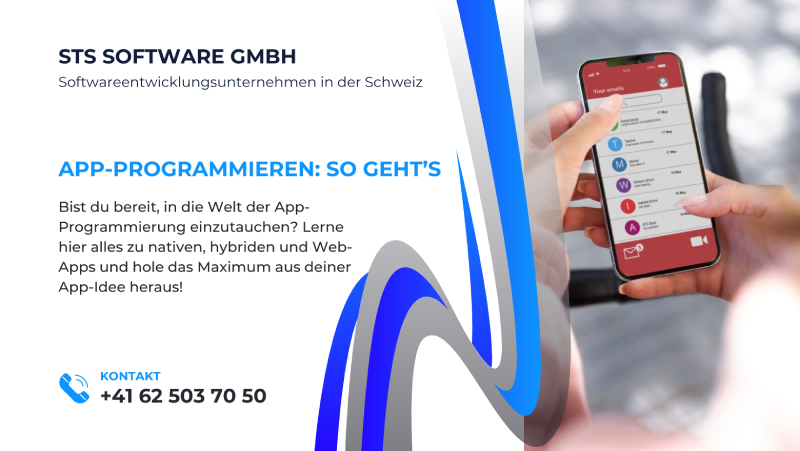
App-Programmieren: So geht’s
Das App-programmieren steht im Mittelpunkt, da die Nachfrage nach mobilen Apps explodiert. Unternehmen müssen sich nun mit zwei Hauptansätzen auseinandersetzen:
- Native Apps programmieren: Die Programmierung nativer Apps für Android (mit Java) und iOS (mit Swift) stellt sicher, dass Ihre Apps hervorragende native Funktionen und eine optimierte Benutzerfreundlichkeit bieten.
- Hybride Apps und Web-Apps programmieren: Diese Apps sind flexibler. Programmiersprachen wie JavaScript und HTML5 unterstützen Unternehmen dabei, hybride und Web-Apps effizient zu erstellen.
Wenn Sie App-Programmierung lernen und selbst eine App programmieren möchten, hilft Ihnen dieser Artikel, die Besonderheiten der App-Programmierung zu verstehen, einschließlich verschiedener App-Typen, deren Vor- und Nachteile und welche Technologien am besten dafür geeignet sind.
Sie wissen nicht, wie man eine App programmiert? Kein Problem! Lassen Sie Ihre App von unseren erfahrenen App-Entwicklern programmieren. Unser Fachwissen und unsere Erfahrung erwecken Ihre App-Idee zum Leben!
App-Programmierung: Eine Einführung

Eine Anwendung (App) ist ein Softwareprogramm, das speziell für mobile Geräte wie Tablets und Smartphones entwickelt wurde. Im Gegensatz zu traditioneller Desktop-Software sind Apps kleiner, für Touchscreens optimiert und auf bestimmte Aufgaben fokussiert. Diese Eigenschaften machen sie für die mobile Nutzung besonders effizient.
Funktionen von Apps
Apps erweitern die Funktionalität mobiler Geräte um neue Features und Möglichkeiten. Beispielsweise bieten Spiele-Apps Unterhaltung mit interaktiven Funktionen, während Produktivitäts-Apps bei der Aufgabenverwaltung helfen. Soziale Medien-Apps sind heutzutage ebenfalls sehr beliebt, da sie die Kommunikation durch die Verbindung von Nutzern weltweit erleichtern.
App-Programmierung
App-Programmierung befasst sich mit der Entwicklung von Software für mobile Geräte. Im Vergleich zu traditionellen Programmen bietet sie einen breiteren Zugriff auf die Hardware.
Apps können Hardware-Komponenten wie GPS für standortbezogene Dienste, Kameras für die Aufnahme von Fotos und Videos sowie Beschleunigungsmesser für die Bewegungserkennung nutzen. Diese Hardware-Integrationen ermöglichen Apps, reichhaltige und interaktive Erlebnisse zu bieten.
Programmierbibliotheken helfen Entwicklern, Wissenslücken zu schließen, indem sie Sammlungen von vorgefertigtem Code bereitstellen. Sie beinhalten zudem erweiterte Funktionen wie den Zugriff auf Sensoren und die Handhabung von Netzwerkkommunikation. App-Entwickler können dadurch komplexe Funktionen einfacher meistern, die Entwicklungszeit optimieren und eine robuste App-Performance sicherstellen.
Arten der App-Programmierung
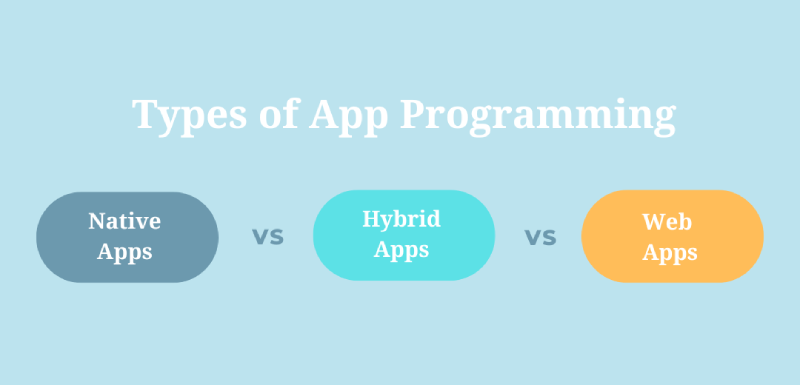
Es gibt verschiedene Arten der App-Programmierung, wie zum Beispiel:
- Native App-Programmierung : Hierbei werden Sprachen wie Java und Kotlin zum Programmieren einer Android-App oder Objective-C und Swift zum Programmieren einer mobilen App für iOS-Geräte verwendet. Dieser Ansatz gewährleistet eine optimierte Leistung und vollständige Integration mit nativer Software und Hardware. Allerdings sind damit höhere Entwicklungskosten und eine längere Entwicklungszeit verbunden.
- Hybride App-Programmierung : Dabei werden Webtechnologien zum Erstellen einer App verwendet, die sich wie native Apps verhalten kann. Auf diese Weise kann die App plattformübergreifend kompatibel sein, niedrigere Kosten verursachen und eine schnellere Entwicklung ermöglichen. Dennoch ist ihre Leistung nicht so robust wie bei nativen Apps.
- Web-App-Programmierung : Hierbei werden Technologien für die Web-App-Programmierung verwendet, um Apps zu erstellen. Benutzer können dann über Webbrowser darauf zugreifen. Diese Apps erfordern keine Installation und sind unabhängig. Allerdings haben sie eingeschränkten Zugriff auf bestimmte Gerätefunktionen.
App-Baukästen: App-Baukästen sind Tools, die es Benutzern ermöglichen, eine App mit wenig bis gar keinen Programmierkenntnissen zu programmieren. Einige bieten sogar kostenlose Optionen für die App-Entwicklung an. So können auch Nicht-Entwickler lernen, eine App zu programmieren, allerdings sind die Anpassungsmöglichkeiten, die Kontrolle und die Leistung begrenzt.
Erfahren Sie mehr: Native App vs. Hybride App vs. Web-App: Den richtigen Weg wählen
Programmiersprachen und Tools für die App-Programmierung
Programmiersprachen und Tools bilden die Grundlage für die Entwicklung von Apps. Zu den beliebtesten Programmiersprachen für Apps gehören:
- Swift für iOS
- Java und Kotlin für Android
- JavaScript für hybride und Web-Apps
Laut einer Untersuchung von Statista sind Java und JavaScript die am weitesten verbreiteten Lösungen. In derselben Umfrage geben mehr als 44% der Befragten an, Apps mit Python zu programmieren.
Entwicklungswerkzeuge, wie Integrated Development Environments (IDEs), sind für die App-Programmierung von Vorteil. Android Studio für Android-Apps und Xcode für iOS-Apps bieten Funktionen für die Codebearbeitung und Fehlerbehebung. Diese Tools vereinfachen den Entwicklungsprozess und sorgen für qualitativ hochwertige Ergebnisse.
Native App-Programmierung: iOS und Android

Native Apps werden für eine bestimmte Plattform programmiert, wie iOS für iPhones/iPads und Android für unterschiedliche Geräte. Aufgrund ihrer nativen Natur bieten diese Apps die beste Leistung, Benutzerfreundlichkeit und Zugriff auf native Funktionen wie GPS, Beschleunigungssensor, Kamera, Gyroskop und Mikrofon.
Das Programmieren einer App auf diese Weise erfordert Kenntnisse plattformspezifischer Programmiersprachen. Für iOS sind dies Swift und für Android Java/Kotlin. Ein App-Programmierer muss diese Fähigkeiten beherrschen, um eine App korrekt für iOS und Android zu programmieren.
Native Android App-Programmierung: Android Studio
Entwickler erstellen Apps für mobile Geräte wie Smartphones und Tablets. Anschließend veröffentlichen sie ihre Arbeit im Google Play Store. Diese Geräte von Herstellern wie Samsung, HTC, Xiaomi und Huawei dominieren den Markt in der DACH-Region (Deutschland, Österreich, Schweiz). In der Schweiz machen sie 47.54% des Marktanteils für mobile Betriebssysteme aus, in Deutschland sogar 65.81%.
Das ultimative Werkzeug für die Android-App-Programmierung ist Android Studio. Dieses kostenlose Open-Source-Programm von Google läuft auf Windows, macOS und Linux. Es bietet so viele Tools, dass Sie auch ohne umfangreiches Vorwissen eine Android-App selbst programmieren können.
Visual Studio ist eine weitere hervorragende Wahl. Wenn Sie eine Android-App mit Visual Studio programmieren, können Sie sie einfach in Microsoft-Dienste und die Azure-Cloud-Plattform integrieren.
Entwickler können auch das Android SDK verwenden, um eine Android-App zu programmieren. Dieses kostenlose Tool kann von der Android-Website heruntergeladen werden. Mit seinen vielen Bibliotheken können Entwickler einfach Java oder andere Sprachen zum Programmieren einer Android-App verwenden.
Bist du bereit, deine eigene Android-App zu erstellen? Lerne jetzt los und entdecke das volle Potenzial der Android-App-Programmierung!
Sieh dir gleich unseren Artikel an: Android App Programmieren: So geht’s
Native iOS App-Programmierung: Xcode
Entwickler programmieren Apple-Apps speziell für Apple-Geräte wie iPads und iPhones. Diese fortschrittlichen Geräte sind bekannt für ihre nahtlose Integration von Hardware und Software, was zu Spitzenleistungen in puncto Performance und Benutzerfreundlichkeit führt. Aufgrund dieser herausragenden Vorteile ist iOS im März 2024 das am weitesten verbreitete Betriebssystem für Smartphone-Nutzer in der Schweiz. Über 47 % der Befragten verwenden es.
Swift wurde 2014 von Apple als primäre Programmiersprache für die iOS-App-Programmierung eingeführt. Diese intuitive und leistungsstarke Sprache eignet sich für alle Entwickler, die eine iPad-App programmieren möchten.
Wenn Sie planen, eine Swift-App zu programmieren, sollten Sie Xcode verwenden, die integrierte Entwicklungsumgebung (IDE) von Apple. Dieses Tool ermöglicht es Entwicklern, die Hardware- und Softwarefunktionen von iOS optimal zu nutzen und so die Programmierung einer iPhone-App zu vereinfachen.
Darüber hinaus unterstützt Xcode Swift und Objective-C. Entwickler können mit dem Interface Builder von Xcode auch die grafische Oberfläche der iOS-App programmieren und deren Funktionalität mit den Testfunktionen testen.
Wollen Sie mit Ihrem iOS-Entwicklungsprojekt erfolgreich starten? Lernen Sie noch heute, eine iOS-App zu programmieren! Xcode steht bereits bereit, Ihnen dabei zu helfen, im Apple-Ökosystem erfolgreich zu sein!
Hinweis zu Windows Phone App-Programmierung
Früher ermöglichte die native Windows Phone App-Programmierung das Erstellen von Apps speziell für die Windows Phone-Plattform von Microsoft. Im Jahr 2026 hat Microsoft jedoch die Entwicklung neuer Funktionen für diese Plattform eingestellt. Infolgedessen ist die Nutzerbasis erheblich geschrumpft.
Die meisten Nutzer sind auf andere Plattformen wie iOS und Android umgestiegen. Außerdem sind Entwickler nicht mehr bereit, Zeit und Ressourcen in die Programmierung einer Windows-App für dieses Betriebssystem zu investieren.
Hybride App-Programmierung: Verschmelzung nativer Apps und Web-Apps

Hybride Apps vereinen Elemente nativer Apps und Web-Apps. Konkret nutzen Entwickler Webtechnologien, um einen einzigen Codebestand zu erstellen, der in einem nativen App-Container ausgeführt wird. So können Entwickler iOS- und Android-Apps mit einem einheitlichen Code programmieren.
Vorteile
Hybride Apps bieten mehrere Vorteile, darunter:
- Schnellere Entwicklung: Die Verwendung eines einzigen Codebestands für verschiedene Plattformen beschleunigt den Entwicklungsprozess.
- Plattformübergreifende Kompatibilität: Die hybride App kann auf verschiedenen Plattformen wie iOS und Android funktionieren.
- Einfachere Wartung: Der App-Programmierer kann Updates und Fehlerbehebungen auf allen Plattformen gleichzeitig durchführen.
Nachteile
Hybride Apps können nicht immer die Leistung nativer Apps erreichen. Darüber hinaus können sie nicht auf alle gerätespezifischen Funktionen zugreifen. Folglich verfügen sie im Vergleich zu vollständig nativen Apps über eingeschränkte Funktionen.
Technologien
Zwei beliebte Frameworks für die Entwicklung hybrider Apps sind:
- React Native: Dieses von Facebook erstellte Framework verwendet JavaScript und React-Komponenten für hybride Apps und ist daher eine beliebte Wahl für Entwickler, die eine App mit JavaScript programmieren möchten.
- Flutter: Flutter, entwickelt von Google, verwendet die Programmiersprache Dart. Entwickler können mit Flutter problemlos eine App programmieren, die auf mehreren Plattformen lauffähig ist.
Web-App-Programmierung
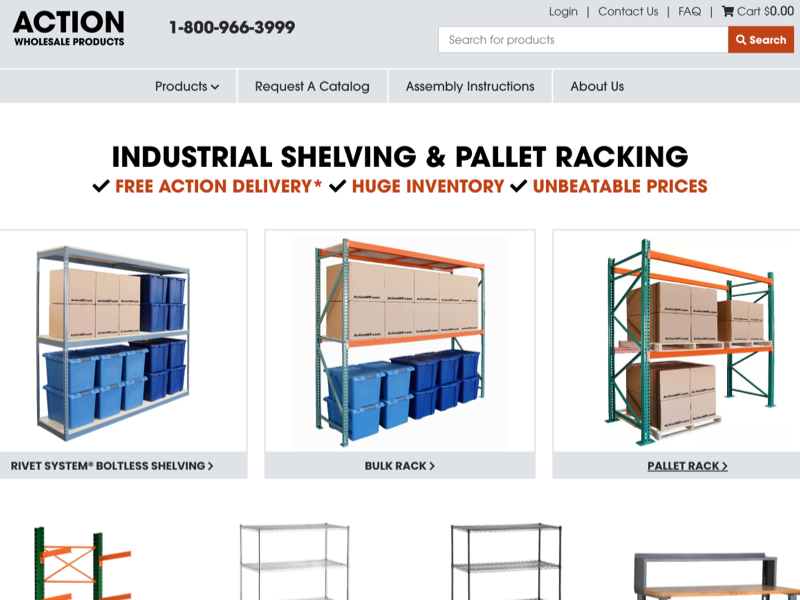
Web-Apps verschmelzen Websites und Apps. Sie werden mit Webentwicklungstechnologien wie CSS und JavaScript erstellt, können aber wie Apps funktionieren. Benutzer können mit jedem Webbrowser auf einem mobilen Gerät darauf zugreifen, was sie zu einer flexiblen und vielseitigen Lösung macht.
Vorteile
Im Gegensatz zu nativen Apps benötigen Web-Apps keine separate Installation auf jedem Gerät. Benutzer müssen daher keine Downloads und Installationen durchführen, was zu einer höheren Nutzerbindung führt.
Ein weiterer Vorteil der Web-App-Programmierung ist der universelle Zugriff. Entwickler programmieren eine App und machen sie dann für alle Benutzer mit beliebigen Geräten zugänglich.
Nachteile
Web-Apps verfügen nicht über viele gerätespezifische Funktionen. Außerdem benötigen sie für eine einwandfreie Funktion eine Internetverbindung.
Daher ist ihre Benutzerfreundlichkeit in Offline-Situationen eingeschränkt. Dies kann zu einer geringeren Gesamtzufriedenheit führen.
Technologien
Um eine Web-App programmieren zu lassen, benötigen Entwickler die richtigen Werkzeuge. Java und Python sind die gängigsten Sprachen für die Programmierung von Webanwendungen. Entwickler können eine Java-App mit Frameworks wie Spring und Java Server Pages (JSP) programmieren. Und um eine Python-App zu programmieren, können sie mit Flask und Django arbeiten. All diese Lösungen sorgen für robuste und skalierbare Web-Apps.
Verwandeln Sie Ihre Idee in Realität. Starten Sie noch heute mit der Web-App-Entwicklung!
Progressive Web Apps (PWAs)
PWAs vereinen die Vorteile traditioneller Web-Apps und nativer mobiler Apps:
- Funktionalität wie native Apps: PWAs können auf dem Startbildschirm installiert werden, offline arbeiten und Push-Benachrichtigungen senden.
- Benutzererfahrung: PWAs bieten im Vergleich zu traditionellen Web-Apps eine schnellere Benutzererfahrung. Sie können auch bei langsamen Netzwerken schnell geladen werden. Außerdem ist das Design responsiv, da sich die App automatisch an verschiedene Bildschirmgrößen anpassen kann.
- Keine App-Store-Freigabe nötig: Im Gegensatz zu nativen Apps benötigen PWAs keine Genehmigung von App-Stores wie Apple oder Google, was den Bereitstellungsprozess beschleunigt. Entwickler können Updates auch schnell an Benutzer weitergeben.
App-Programmierung leicht gemacht – Der App-Baukasten
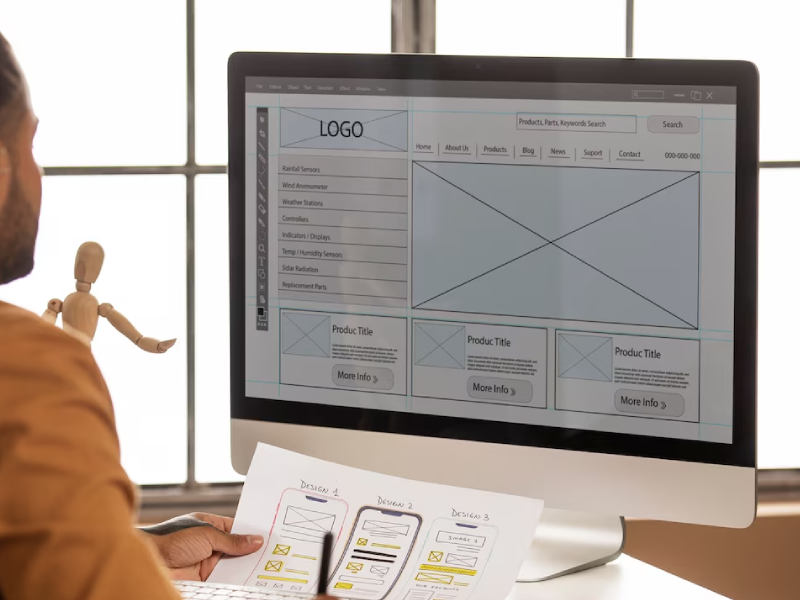
Der App-Baukasten ist eine Software-Plattform, die Ihnen hilft, kostenlos Ihre eigene App zu programmieren. Er richtet sich an Anfänger mit wenig Programmierkenntnissen und bietet wiederverwendbare Vorlagen mit Drag-and-Drop-Funktionen, was die Erstellung benutzerfreundlicher Oberflächen erleichtert.
App-Baukästen stellen Anwendern vorgefertigte Komponenten und anpassbare Layouts zur Verfügung. Dieser Ansatz vereinfacht den Entwicklungsprozess und ermöglicht es Benutzern, schnell funktionale Apps zu erstellen, ohne Code schreiben zu müssen.
Trotzdem haben App-Baukästen auch Nachteile. Zum Beispiel bieten die vorgefertigten Elemente möglicherweise nicht den Grad an Anpassung, den Ihre komplexen Projekte benötigen.
Darüber hinaus fehlen Apps, die mit App-Baukästen erstellt wurden, häufig erweiterte Funktionen, was zu weniger komplexen Apps führt.
App-Programmierung: Den richtigen Weg wählen
Die Wahl des richtigen Entwicklungsansatzes ist der erste Schritt beim Programmieren einer mobilen App. Hier sind die wichtigsten Faktoren, die Sie bei Ihrem Projekt berücksichtigen sollten:
Komplexität Ihrer App
Wenn Ihre App komplexe Funktionen und eine tiefgehende Integration mit Gerätefunktionen erfordert, ist die native App-Programmierung möglicherweise die beste Wahl. Sie ermöglicht die höchste Leistung und den Zugriff auf alle gerätespezifischen Funktionen, wodurch eine effiziente Benutzererfahrung geboten wird.
Zielgruppe
Wenn Ihre Zielgruppe nur einen Gerätetyp verwendet (iOS oder Android), kann die native Entwicklung die höchste Benutzerzufriedenheit garantieren. Inzwischen sind hybride oder Web-App-Programmierungen besser geeignet, wenn Sie ein breites Publikum auf verschiedenen Plattformen erreichen möchten.
Entwicklungsressourcen und Budget
Hybride und Web-Apps können schneller und kostengünstiger entwickelt werden. Sie können auch einen App-Baukasten verwenden, um die Programmierkosten zu senken und die Entwicklungszeit zu optimieren.
Gewünschte Benutzererfahrung
Native App-Entwicklung ist bekannt für ihre hochintegrierte Benutzererfahrung. Native Apps bieten die beste Leistung, Benutzererfahrung und den besten Zugriff auf Gerätefunktionen.
Zusätzliche Option
Progressive Web Apps (PWAs) vereinen das Beste aus beiden Welten. Sie bieten eine reaktionsschnellere Benutzererfahrung als traditionelle Web-Apps und können offline funktionieren. Außerdem können Benutzer sie auf dem Startbildschirm installieren, ohne dass eine App-Store-Genehmigung erforderlich ist.
Programmieren Sie Ihre eigene App mit der STS Software GmbH
Wie schwierig ist es, eine App zu programmieren? Was kostet die Programmierung einer App? Oder möchten Sie Ihre App lieber selbst programmieren? Ganz gleich, welches Anliegen Sie haben, die STS Software GmbH kann Ihnen helfen, den Wert und den Erfolg Ihres Projekts zu steigern. Durch eine Partnerschaft mit uns profitieren Sie von folgenden Vorteilen:
- Die STS Software GmbH ist ein führendes Unternehmen für mobile App-Entwicklung in der Schweiz.
- Wir bieten wettbewerbsfähige Preise, um eine kostengünstige Lösung für Ihr Projekt zu gewährleisten, ohne dabei die Qualität zu beeinträchtigen.
- Wir verfügen über Fachwissen in vielen Branchen (Gesundheitswesen, Banken, Einzelhandel usw.), sodass Ihre App den Branchenstandards und spezifischen Anforderungen gerecht wird.
- Unser Team von über 50 qualifizierten App-Programmierern arbeitet sorgfältig und professionell daran, eine App zu programmieren, die genau auf Ihre Bedürfnisse zugeschnitten ist.
- Wir nutzen modernste Technologien wie KI, ML und Cloud-basierte Lösungen, um Innovation in jedes Projekt zu bringen.
- Mit Geheimhaltungsvereinbarungen (NDA) und ISO-Zertifizierungen können wir Android-Apps oder iOS-Apps mit höchstem Sicherheitsniveau programmieren.
Sind Sie bereit, Ihre App zu entwickeln? Entdecken Sie unsere Dienstleistungen für die mobile App-Entwicklung!
Abschluss
Es gibt verschiedene Wege in der App-Programmierung. Native Apps bieten die beste Leistung und den umfassendsten Zugriff auf Gerätefunktionen, während hybride und Web-Apps plattformübergreifend kompatibel sind und eine schnellere Entwicklungszeit ermöglichen.
Die kontinuierliche Weiterentwicklung von Tools und Frameworks vereinfacht die App-Programmierung stetig. Ganz gleich, ob Sie selbst programmieren lernen oder Profis für Ihr Projekt beauftragen möchten – bleiben Sie über diese Entwicklungen auf dem Laufenden, um Ihren Erfolg zu sichern!
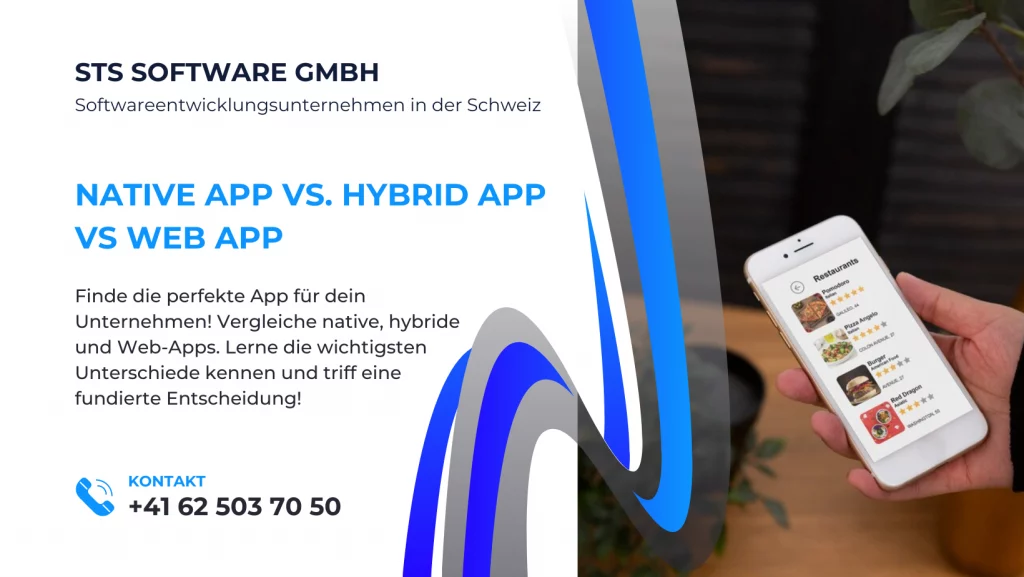
Native-App vs. Hybrid-App vs. Web-App: Die richtige Wahl für Ihr Projekt
Was sollten Sie zwischen einer nativen App, einer hybriden App und einer Web-App wählen? Jede bietet einzigartige Vorteile und Herausforderungen. Ohne richtige Planung wird Ihr App-Entwicklungsprojekt scheitern und Sie verschwenden am Ende Zeit und Geld.
In der Schweiz, wo der App-Markt voraussichtlich 3.004 Millionen US-Dollar im Jahr 2027 erreichen wird, ist die richtige Wahl für mobile App-Lösungen noch entscheidender. Wenn Sie eine App entwickeln lassen möchten, dient dieser Artikel als Leitfaden, um Ihnen zu helfen, die verschiedenen Arten von Apps zu verstehen und eine fundierte Entscheidung zu treffen. Indem Sie die Benutzerbedürfnisse kennenlernen und verschiedene App-Entwicklungsoptionen prüfen, können Sie eine neue App erstellen, die auf den Schweizer Markt zugeschnitten ist. Also, lesen wir weiter!
Was sind native Apps?
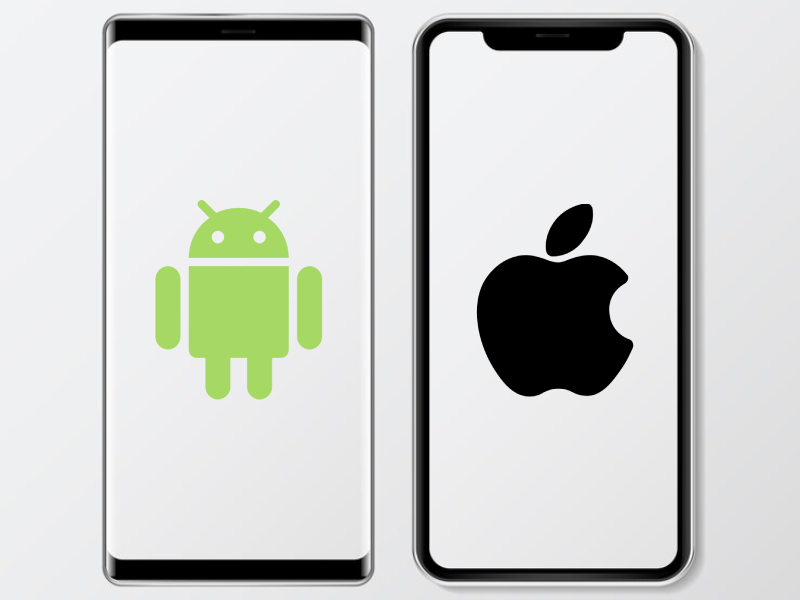
Was ist eine native App? Wie lange dauert es, eine native App zu erstellen? Obwohl dieser Ansatz zu höheren Kosten und längerer Entwicklungszeit führt, bietet er ein überragendes Benutzererlebnis.
Native Apps verstehen
Native Apps sind Apps, die Entwickler speziell für ein bestimmtes Gerät oder eine bestimmte Plattform erstellen. Benutzer können sie aus App-Stores herunterladen, beispielsweise dem Apple App Store für iOS-Geräte und dem Google Play Store für Android-Geräte.
Der Entwicklungsprozess für native Apps umfasst die Verwendung plattformspezifischer Frameworks und Programmiersprachen. Beispielsweise verwenden Entwickler Objective-C oder Swift, um iOS-Apps zu erstellen. Inzwischen benötigen Android-Apps Java oder Kotlin.
Der Entwicklungsprozess für native Apps umfasst die Verwendung plattformspezifischer Frameworks und Programmiersprachen. Hier eine Aufschlüsselung nach Plattform:
1. iOS-App-Programmieren
– Verwendet Xcode (neueste Version ist Xcode 15), die offizielle integrierte Entwicklungsumgebung (IDE) von Apple.
– Programmiersprachen umfassen Objective-C oder Swift.
2. Android-App-Programmieren
– Verwendet Android Studio (neueste Version ist Android Studio Koala), die offizielle integrierte Entwicklungsumgebung (IDE) von Google.
– Programmiersprachen umfassen Java oder Kotlin.
Erfahren Sie mehr: Android App Programmieren: So geht’s
Entwicklungszeit
Native Programmierung benötigt mehr Zeit als Web-Apps, da Entwickler zwei Codebasen für Android und iOS erstellen und pflegen müssen. Benötigt die App die Integration mit Gerätefunktionen wie GPS oder Kamera, steigt die Komplexität der Entwicklung einer nativen Anwendung, was die Entwicklungszeit verlängert.
Entwicklungskosten
Native Entwicklung ist aufgrund der separaten Entwicklung für iOS- und Android-Apps die teuerste Option. Darüber hinaus kann die Einstellung von Entwicklern mit Expertise in bestimmten Programmiersprachen kostspielig sein. Und wenn die App erweiterte Funktionen benötigt, steigen die Kosten weiter.
Vorteile von nativen Apps
Die Entwicklung einer nativen mobilen App bietet enorme Vorteile in Bezug auf Leistung, Zugriff auf Funktionen und Benutzerfreundlichkeit.
Optimale Leistung
Dem Konzept nach sind native Apps auf ein bestimmtes Betriebssystem zugeschnitten. Beispielsweise ist eine iOS-App für die Arbeit auf Apple-Geräten konzipiert. Für das jeweilige Betriebssystem optimiert, läuft die App sicherlich reibungslos und reagiert mit bestmöglicher Geschwindigkeit.
Voller Zugriff auf Funktionen
Stellen Sie sich Pokemon Go als Beispiel für eine native App vor. Sie hat direkten Zugriff auf alle Funktionen und Funktionalitäten des Geräts, wie GPS und Kamera. Diese Vollzugriffsfunktion gilt für alle nativen Apps.
Benutzerfreundlichkeit
Viele Unternehmen programmieren eine native App, um ein reibungsloses, natives Gefühl zu bieten, das auf bestimmte Betriebssysteme zugeschnitten ist. Ob sie eine native iOS-App oder eine native Android-App entwickeln, können sie ihre Zielgruppe zufrieden stellen.
Nachteile von nativen Apps
Entwicklungszeit und -kosten sind die größten Nachteile von nativen Apps. Entwickler müssen sich außerdem mit der App-Store-Zulassung und der eingeschränkten Zugänglichkeit auseinandersetzen.
Langsamere Entwicklung und höhere Kosten
Um eine native App zu entwickeln, arbeiten Entwickler mit separaten Codebasen für Android und iOS, was die Entwicklungszeit und die Kosten erhöht. Abhängig von den Projekt Anforderungen können zusätzliche Kosten entstehen.
App-Store-Genehmigungsprozess
Nach der Entwicklung müssen Sie die App beim App-Store einreichen. Dieser Prozess beinhaltet eine Genehmigung durch den Store. Darüber hinaus muss die App die strengen Richtlinien und Regeln des Stores erfüllen. Die Provisionsrate ist ein weiteres Problem. Apple verlangt von Ihnen mindestens 30% Provision für reguläre Abonnements im App Store.
Begrenzte Zugänglichkeit
Im Vergleich zu Web-Apps erreichen native Apps ein kleineres Publikum, da Benutzer sie nur aus dem richtigen App-Store herunterladen können. Wenn Sie also eine native Android-App entwickeln, können iOS-Benutzer sie nicht auf ihren iOS-Geräten installieren.
Was sind hybride Apps?
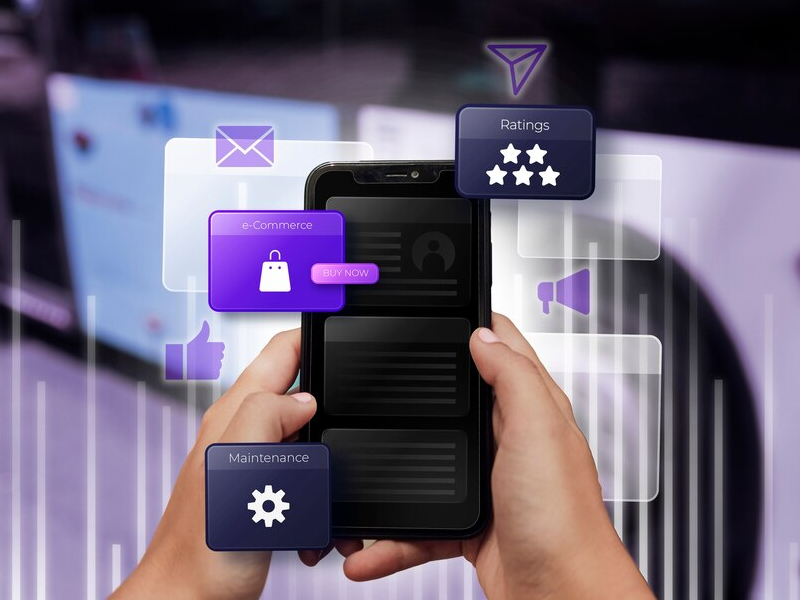
Hybride Apps bieten schnelle Entwicklungszeiten, Kosteneffizienz und Plattformübergreifende Funktionen. Sie haben jedoch auch Einschränkungen.
Hybride Apps verstehen
Hybride Apps kombinieren native Apps mit Web-Apps. Daher verfügen sie über einige native Funktionen innerhalb eines Web-App-Containers, sodass sie auf verschiedenen Plattformen laufen können. Beliebte Frameworks für hybride Apps sind React Native, Flutter, Xamarin und Phonegap/Apache Cordova.
Entwicklungszeit
Hybride Apps können schneller entwickelt werden als native Apps, wenn ihre Kernfunktionen auf Webtechnologien basieren. Einige native Funktionen können jedoch die Komplexität erhöhen und die Entwicklungszeit verlängern.
Entwicklungskosten
Die Entwicklung hybrider mobiler Apps kostet weniger als die Entwicklung nativer Apps. Die genauen Kosten hängen jedoch von der Abhängigkeit von Webtechnologien und der Komplexität der nativen Funktionen ab.
Vorteile von hybriden Apps
Viele Beispiele für hybride Apps können ihre spürbaren Vorteile in Bezug auf Kosteneinsparung und Zugänglichkeit demonstrieren.
Schnellere Entwicklung und geringere Kosten
Die hybride Entwicklung verwendet einen einzigen Code für mehrere Plattformen. Dadurch kann der Entwicklungsprozess beschleunigt werden. Die Verwendung einer einzigen Codebasis bedeutet auch weniger Ressourcen und geringere Entwicklungskosten.
Breitere Zugänglichkeit
Benutzer können auf hybride Apps von mehreren Plattformen und Geräten aus zugreifen, ohne sie aus App-Stores herunterladen zu müssen. Auf diese Weise können Unternehmen eine breitere Benutzerbasis erreichen.
Native Funktionen
Hybride Apps verfügen über herausragende native Funktionen durch Frameworks oder Plugins. Das bedeutet, dass sie über erweiterte Funktionen verfügen.
Nachteile von hybriden Apps
Im Vergleich zu nativen Apps weisen hybride Apps eine eingeschränkte Leistung und Benutzerfreundlichkeit auf.
Leistung
Hybride Apps sind auf native Browser angewiesen. Obwohl sie sich leicht aktualisieren lassen, können einige UI-Probleme zu Störungen führen. Daher funktionieren die Apps möglicherweise nicht so gut wie native Apps, insbesondere bei komplexen Interaktionen mit einigen Gerätefunktionen.
Eingeschränkte native Funktionen
Hybride Apps verfügen zwar über native Funktionen, diese sind jedoch möglicherweise nicht vollständig zugänglich. Für erweiterte Gerätefunktionen benötigen sie eine kundenspezifische Entwicklung.
Benutzerfreundlichkeit
Die Benutzerfreundlichkeit in hybriden Apps fühlt sich oft weniger ausgereift an als in vollständig nativen Apps. Wenn Sie sich beispielsweise mehr auf Android-Geräte konzentrieren, wird die iOS-Seite schlechter sein und umgekehrt.
Was sind plattformübergreifende Apps?
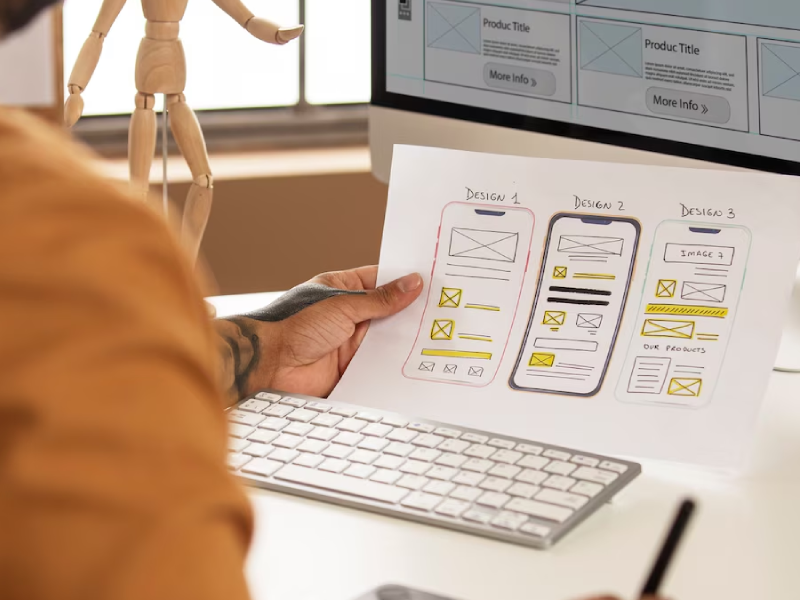
Plattformübergreifende Apps können auf mehreren Betriebssystemen und Plattformen funktionieren. Entwickler können sogar ihren Quellcode teilen.
Plattformübergreifende Apps verstehen
Plattformübergreifende Apps werden mit einer Zwischensprache erstellt, die nicht nativ für das Betriebssystem eines Geräts ist. Stattdessen werden sie mit Frameworks wie Flutter, React Native oder Xamarin in das Zielsystem kompiliert. Entwickler können den Code für verschiedene Plattformen freigeben, einschließlich Android und iOS.
Entwicklungszeit
Die Verwendung einer einzigen Codebasis für mehrere Plattformen verkürzt die Entwicklungszeit. Einige Funktionen erfordern jedoch native Plugins und Module, was die gesamte Entwicklungsdauer etwas verlängert.
Entwicklungskosten
Die Entwicklung von plattformübergreifenden Apps ist aufgrund der gemeinsamen Codebasis in der Regel kostengünstiger als die native Entwicklung. Entwickler können Ressourcen auch optimieren, wenn sie bereits Kenntnisse im gewählten Framework besitzen.
Vorteile von plattformübergreifenden Apps
Die Entwicklung plattformübergreifender Apps schafft ein Gleichgewicht zwischen nativer Leistung und Benutzerfreundlichkeit, unterstützt die Integration nativer Plugins und bietet Entwicklungseffizienz.
Ausgeglichene Leistung und Benutzerfreundlichkeit
Die plattformübergreifende App-Entwicklung ermöglicht die Ausführung der App auf mehreren Plattformen und Geräten. Gleichzeitig kann sie eine Leistung liefern, die an native Apps heranreicht. Mit anderen Worten, die plattformübergreifende Entwicklung schafft ein Gleichgewicht zwischen nativer Leistung und Benutzerfreundlichkeit auf verschiedenen Geräten.
Integration nativer Plugins
App-Frameworks für die plattformübergreifende Entwicklung integrieren native Plugins für einige Funktionen mit nativem Aussehen und voller Leistung. Entwickler können ihrer Arbeit problemlos native Module hinzufügen.
Entwicklungseffizienz
Einer der größten Vorteile der plattformübergreifenden App-Entwicklung ist die Effizienz der Codewiederverwendung. Auf diese Weise schreiben Entwickler die Kernlogik einmal und verwenden sie für mehrere Plattformen wieder. Letztendlich können sie so Zeit und Kosten sparen.
Nachteile von plattformübergreifenden Apps
Trotz der beeindruckenden Vorteile stellen plattformübergreifende Apps Entwickler aus folgenden Gründen vor Herausforderungen:
Beschränkte native Funktionen
Obwohl plattformübergreifende Apps über native Plugins verfügen, kann der Zugriff auf erweiterte native Funktionen weiterhin eingeschränkt sein. Dieser Nachteil verhindert, dass die App die Funktionen eines bestimmten Betriebssystems vollständig nutzen kann.
Verringerte Leistung
Diese Apps erreichen nicht die gleiche Leistung wie native Apps. Der einheitliche Technologie-Stack ist weniger flexibel, was zu einem Verlust der Leistungsoptimierung führt. Es kann auch zu Unterschieden in den UX/UI-Designs auf verschiedenen Betriebssystemen kommen.
Framework-Abhängigkeit
Das für den Entwicklungsprozess gewählte Framework spielt eine entscheidende Rolle. Die Funktionalität und Leistung der App werden beeinträchtigt, wenn das Framework einige Funktionen nicht unterstützt.
Was sind Web-Apps?
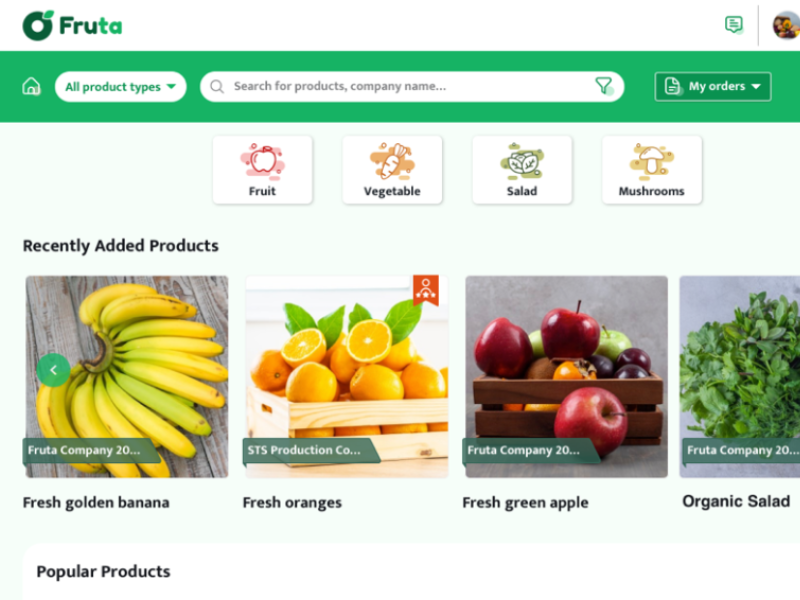
Web-Apps werden auf einem Server gespeichert und laufen im Internet. Benutzer können problemlos auf die Apps zugreifen, ohne sie auf ihren Geräten installieren zu müssen.
Web-Apps verstehen
Webanwendungen laufen innerhalb eines Webbrowsers. Benutzer können über einen Uniform Resource Locator (URL) darauf zugreifen. Die Entwicklung von Web-Apps umfasst die Verwendung verschiedener Frontend- und Backend-Frameworks:
- Frontend: Vue.js, Angular.js oder React.js zum Erstellen reaktionsschneller Benutzeroberflächen (Client-Seite).
- Backend: Node.js, ASP.NET Core oder Ruby on Rails für die Verwaltung von Infrastruktur und Daten (Server-Seite).
Entwicklungszeit
Um Ihre eigene Web-App zu erstellen, müssen Sie lediglich eine einzige Codebasis für alle Plattformen verwenden. Daher steht diese Art von App an erster Stelle, wenn es um eine schnelle Entwicklungszeit geht. Andere Faktoren, die die Zeit beeinflussen, sind die verwendeten Frontend-Frameworks und die Komplexität der Funktionen.
Entwicklungskosten
Die einzige Codebasis reduziert auch die Programmierkosten für Web-Apps. Entwickler können ihr vorhandenes Know-how in der Webentwicklung für die Aufgabe nutzen. Die Entwicklungskosten können jedoch je nach den Funktionen der App und den Anforderungen der Backend-Entwicklung steigen.
Vorteile von Web-Apps
Web-Apps sind kostengünstige und effiziente Lösungen. Hier einige Vorteile, die sie bieten:
Schnelle Entwicklung und kostengünstig
Die einzige Codebasis spart Entwicklern Zeit und Kosten bei der Programmierung von Webanwendungen. Viele Entwickler verfügen bereits über Kenntnisse in der Verwendung des JavaScript-Frameworks, das weltweit am häufigsten verwendete Webframework ist. Ihr Fachwissen wird die Entwicklungskosten und die Schulungszeit weiter senken.
Breite Zugänglichkeit
Entwickler erstellen eine Webanwendung und senden die URL an die Benutzer. Benutzer können dann sofort mit der Verwendung der App beginnen. Sie können sogar mit jedem Gerät mit einem Webbrowser darauf zugreifen. Im Vergleich zwischen einer Web-App und einer nativen App gewinnt die erste in puncto Benutzerfreundlichkeit, da Sie sie nicht installieren oder auf die Genehmigung durch den Store warten müssen.
Einfache Wartung
Änderungen an einer Web-App werden auf der Serverseite vorgenommen. Anschließend werden sie auf allen Plattformen gleichzeitig aktualisiert. Das bedeutet, dass Benutzer immer die neueste Version haben, ohne die App selbst aktualisieren zu müssen.
Sind Sie bereit, eine leistungsstarke und benutzerfreundliche Webanwendung zu erstellen? Lassen Sie die Entwicklung von unseren Web-Experten übernehmen. Erfahren Sie mehr über unsere Dienstleistungen zur Web-App-Entwicklung!
Nachteile von Web-Apps
Für die Entwicklung einer Web-App müssen Sie sich mehreren Herausforderungen stellen, wie zum Beispiel:
Begrenzte Funktionalität
Benutzer können mit jedem Browser auf die Web-Apps zugreifen. Leider bedeutet dies auch, dass die Apps auf eine Internetverbindung angewiesen sind. Außerdem fehlen ihnen möglicherweise erweiterte Funktionen wie GPS oder eine Kamera.
Leistung
Ein weiteres Problem bei der Programmierung einer Web-App ist, dass sie möglicherweise langsamer als native Apps arbeitet, insbesondere bei komplizierten Funktionen. Native Apps gewinnen in dieser Hinsicht, da sie für die Leistung auf einem bestimmten Betriebssystem optimiert sind.
Benutzerfreundlichkeit
Selbst wenn Entwickler ihr Bestes geben, um eine Web-App zu entwickeln, fühlt sich das Produkt möglicherweise weniger ausgereift und reaktionsschnell an als native Apps. Sie müssen zusätzliche Anstrengungen unternehmen, um sicherzustellen, dass die App ein zufriedenstellendes Erlebnis bietet. share more_vert
Was sind Progressive Web Apps (PWAs)?
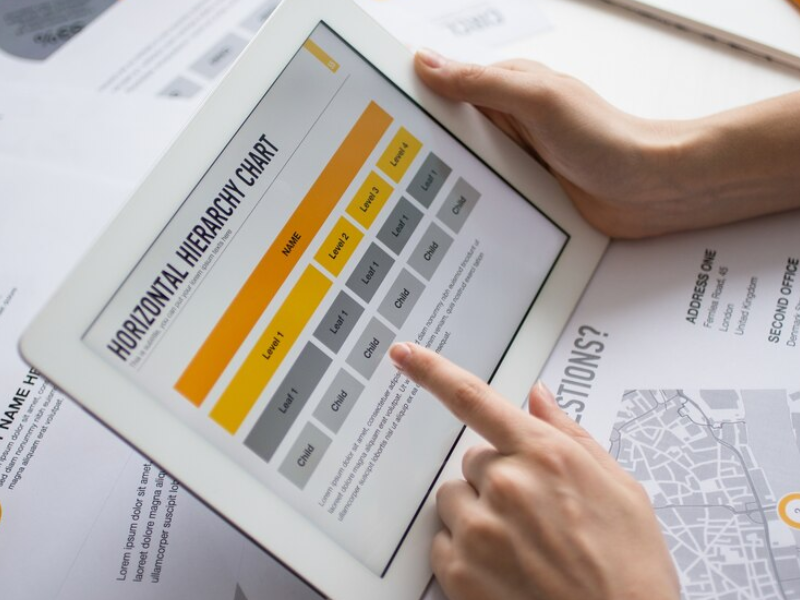
Progressive Web Apps (PWAs) erfreuen sich aufgrund ihrer verbesserten Benutzerfreundlichkeit wachsender Beliebtheit. Twitter hat auf PWAs umgestellt und konnte dadurch die Seiten pro Sitzung um 65 %und die Tweets um 75 % steigern. Auch Hulu und Nikkei haben diese Methode erfolgreich eingesetzt.
Progressive Web Apps (PWAs) verstehen
PWAs sind Web-Apps mit App-ähnlichen Funktionen wie Offline-Funktionalität und Push-Benachrichtigungen. Entwickler müssen die App lediglich online veröffentlichen, damit jeder darauf zugreifen kann. Zu den Werkzeugen und Bibliotheken, die für die Entwicklung progressiver Web-Apps verwendet werden, gehören PWA-Builder, Lighthouse und Workbox.
Entwicklungszeit
Die Entwicklungszeit für eine progressive Web-App kann ähnlich lang sein wie für traditionelle Web-Apps, da beide auf bestehenden Webtechnologien und Frameworks basieren. Allerdings kann die Entwicklung von PWA-spezifischen Funktionen wie Offline-Funktionalität und Service Workern etwas mehr Zeit in Anspruch nehmen.
Entwicklungskosten
Die Kosten für die PWA-Entwicklung entsprechen denen für Web-Apps. Allerdings fallen für PWA-spezifische Funktionen zusätzliche Kosten an.
Vorteile von Progressive Web Apps (PWAs)
Die PWA-Technologie bietet eine brillante Mischung aus Web- und nativen App-Funktionen. Sie trägt auch dazu bei, Entwicklungszeit und -kosten zu senken.
Kombination von Web- und nativen Funktionen
PWAs verfügen über App-ähnliche Funktionen und sehen dabei wie Web-Apps aus. Somit schlagen sie eine Brücke zwischen Web-Apps und nativen Apps. Diese Kombination ermöglicht es Benutzern, PWAs einfach auf ihrem Homescreen zu installieren.
Schnelle Entwicklung und geringere Kosten
PWAs nutzen bestehende Kenntnisse und Werkzeuge der Webentwicklung, was zu einer schnelleren Entwicklung und niedrigeren Kosten führt. Werkzeuge wie Android Studio können den Prozess zusätzlich beschleunigen.
Breite Zugänglichkeit
Sie müssen die PWA nicht im App Store suchen. Stattdessen ist die App über einen Webbrowser auf jedem Gerät zugänglich. Eine Installation ist daher nicht erforderlich.
Nachteile von Progressive Web Apps (PWAs)
Trotz der Vertrauenswürdigkeit des Webs weisen PWAs immer noch zwei große Einschränkungen auf:
Eingeschränkte native Funktionen
PWAs können nicht alle Gerätefunktionen unterstützen. Das Fehlen bestimmter Gerätefunktionen kann sich auf einige Funktionalitäten und die Benutzerfreundlichkeit auswirken.
Eingeschränkte PWA-Funktionalität
Die Funktionen von PWAs befinden sich noch in der Entwicklung. Daher können ihre Fähigkeiten manchmal nicht mit den neuesten Fortschritten in der Entwicklung nativer Apps mithalten.
Die richtige Wahl treffen: Native Apps vs. Hybride Apps vs. Web-Apps
Alle drei Arten von Apps bieten ihre eigenen Vor- und Nachteile. Die beste Wahl hängt von Ihren individuellen Anforderungen ab.
Wann sollte man eine native App wählen?
Native Apps sind ideal für leistungsorientierte Anwendungen, die umfangreiche Offline-Funktionalität benötigen. Sie unterstützen auch die tiefe Integration mit Gerätefunktionen wie GPS und Kamera.
Beispielsweise erfordert eine native Anwendung wie ein Fitness-Tracker die kontinuierliche Datenaufzeichnung, auch offline, während Apps zur Fotobearbeitung Zugriff auf die Kamera benötigen. Diese Beispiele für native Apps zeigen die Vorteile des vollen Gerätezugriffs und der optimierten Leistung.
Wann sollte man eine hybride App wählen?
Die Entwicklung hybrider Apps eignet sich am besten für eine schnellere Entwicklung mit einigen nativen Funktionen, insbesondere wenn Kernfunktionen mit Webtechnologien entwickelt werden können.
Eine hybride App mit To-Do-Listen und Notizfunktionen eignet sich für Unternehmen, die einfache Produktivitätslösungen erstellen möchten. Sie können auch interne Apps mit bestimmten Anforderungen an Gerätefunktionen verwenden. Wie Sie an diesen beiden Beispielen für hybride Apps sehen können, können hybride Apps Anforderungen effizient erfüllen, ohne dass umfangreiche Ressourcen benötigt werden.
Wann sollte man eine Web-App wählen?
Wenn Sie weit zugängliche Apps, inhaltsgesteuerte Apps oder Apps suchen, die mit Webfunktionen arbeiten, sollten Sie möglicherweise eine Web-App entwickeln. Beispiele für Web-Apps sind Nachrichtenseiten, Online-Shops und Social-Media-Plattformen. Diese benötigen ständige Aktualisierungen, um Benutzer auf dem Laufenden zu halten.
Sie können sogar eine Web-App mit PWAs verwenden, um die Funktionalität zu verbessern. Aber wann sollten Sie sich für eine PWA entscheiden?
PWAs zeichnen sich aus, wenn die Auffindbarkeit der App Ihr Hauptanliegen ist. Sie interessieren sich nicht für die Installation nativer Apps und möchten einfach eine Mischung aus appähnlichen Funktionen und Zugänglichkeit.
Ihre Vorteile können Sie anhand der folgenden Beispiele für progressive Web-Apps kennenlernen:
- Mit Ride-Hailing-Apps können Benutzer Fahrten buchen und ihre Routen verfolgen.
- Restaurantmenüs helfen Benutzern, die Speisekarte zu durchsuchen und Bestellungen aufzugeben.
- Treueprogramme ermöglichen Benutzern den Zugriff auf ihre Punkte und Prämien, wenn sie einen Dienst abonnieren.
In solchen Fällen können Sie durch die Entscheidung für PWAs das Beste aus beiden Welten von nativen Apps und Web-Apps herausholen. Letztendlich bieten Sie Ihrer Zielgruppe ein nahtloses Erlebnis.
Vergleichstabelle: Native Apps vs Hybride Apps vs. Web-Apps
Es gibt viele Unterschiede zwischen nativen Apps, hybriden Apps und Web-Apps. Die folgende Tabelle hebt ihre herausragenden Funktionen, Vor- und Nachteile sowie ideale Anwendungsfälle hervor, um Ihnen eine fundierte Entscheidung zu ermöglichen.
| Native Apps | Hybride Apps |
Web Apps |
|
| Features | – Zugriff auf Gerätefunktionen
– Hohe Performance – Natives Aussehen und Bediengefühl |
– Single Codebase für mehrere Plattformen
– Zugriff auf einige native Funktionen |
– Im Webbrowser nutzbar
– Basiert auf Webtechnologien |
| Vorteile | – Optimale Performance
– Voller Zugriff auf Gerätefunktionen – Ansprechende Benutzererfahrung |
– Schnelle Entwicklung & geringere Kosten
– Breite Zugänglichkeit – Gewisse native Funktionalitäten |
– Schnelle Entwicklung & geringere Kosten
– Breite Zugänglichkeit – Einfache Wartung |
| Nachteile | – Hohe Entwicklungszeit & -kosten
– App Store-Genehmigung erforderlich – Begrenzte Zugänglichkeit |
– Schlechtere Performance für komplexe Funktionen
– Eingeschränkte native Funktionen – Weniger reaktionsschnelle Benutzererfahrung |
– Begrenzte Funktionalität
– Langsame Performance bei komplexen Features – Weniger reaktionsschnelle Benutzererfahrung |
| Ideale Anwendungsfälle | Performancekritische Apps | Plattformübergreifende Apps mit Basisfunktionen | Contentbasierte Apps & solche mit Webfunktionalität |
STS Software GmbH – Wir helfen Ihnen, den richtigen Weg zu wählen
Die STS Software GmbH ist ein führendes Unternehmen für mobile App-Entwicklung in der Schweiz. Egal, ob Sie native Apps, hybride Apps, plattformübergreifende Apps oder Web-Apps (erweitert mit PWAs) benötigen, wir bieten Ihnen erstklassige Dienstleistungen, um Ihren Erfolg zu sichern.
Mit einer starken Präsenz in der Schweiz und in Deutschland verfügt die STS Software GmbH über umfassende Erfahrung und Expertise, um Ihnen bei der Auswahl der besten Lösung für Ihre Bedürfnisse zu helfen. Unsere talentierten App-Entwickler beherrschen verschiedene Programmiersprachen, Frameworks und Technologien. Wir wissen, was für Ihr Unternehmen am besten funktioniert.
Sind Sie bereit, eine App entwickeln zu lassen? Arbeiten Sie noch heute mit der STS Software GmbH zusammen und lassen Sie sich von unseren App-Entwicklungsexperten bei der Wahl des richtigen Wegs für Ihr Projekt unterstützen!
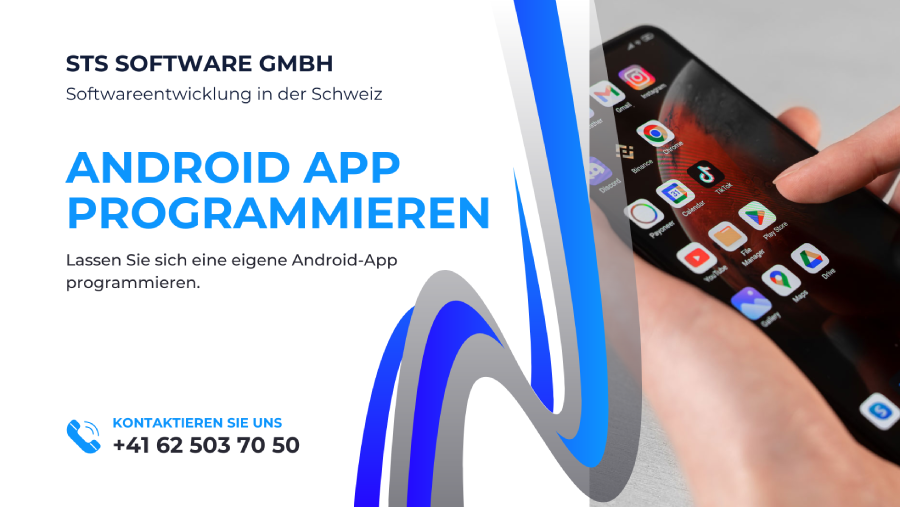
Android App Programmieren: So geht’s
Android App Programmieren: Wie erstelle ich meine eigenen Apps für Android-Geräte? Bevor wir tiefer einsteigen, werfen wir einen Blick auf einige wichtige Statistiken zur Android-Plattform. Die Android-Plattform hat in der Schweiz einen bedeutenden Marktanteil von 47.45%. Diese Popularität führt zu einer steigenden Nachfrage nach qualifizierten Android-Entwicklern. Unabhängig davon, ob Sie Ihre eigene Android-App programmieren oder professionelle Hilfe in Anspruch nehmen möchten, müssen Sie die Grundlagen verstehen. Die STS Software GmbH führt Sie daher durch die Schritte zum Programmieren einer App für Android.
App programmieren lassen? Jetzt Android-Entwickler finden!
Android-Betriebssystem als Grundlage

Android ist ein quelloffenes und kostenloses Betriebssystem, das von Google entwickelt wurde. Die quelloffene Natur trägt zu ihrer weit verbreiteten Nutzung bei. Viele Hersteller wie Huawei, HTC, Xiaomi und Samsung verwenden all dieses Betriebssystem.
Vielseitigkeit und Kernfunktionen
Android befindet sich mittlerweile in der 14. Version, genannt Android 14. Entwickler können damit Android-Apps für verschiedene Geräte programmieren, wie Smartphones, Smartwatches, Fernseher und Tablets.
Android app programmieren garantiert robuste Leistung und Sicherheit. Um die Kernfunktionalität zu nutzen, benötigen Sie einen modifizierten Linux-Kernel.
Um Android-Apps zu programmieren, benötigen Sie außerdem die Installation von Android Studio. Dieses Software Development Kit (SDK) enthält alle Werkzeuge, um eine App mit Java oder Kotlin zu programmieren. Die Android-App-Programmierung mit Android Studio ermöglicht funktionsfähige Produkte.
Herausforderungen der plattformübergreifenden Entwicklung
Nach der Programmierung einer Android-App müssen Sie diese in den App Store hochladen. Der App Store für Android-Geräte heißt Google Play Store. Entwickler können Apps für den Google Play Store erstellen und sicherstellen, dass sie auf verschiedenen Geräten unterschiedlicher Hersteller problemlos zugänglich sind.
Android-Apps können jedoch aufgrund unterschiedlicher Software Plattformen nicht auf Apple-Geräten ausgeführt werden. Jede Plattform verfügt über spezifische Programmiersprachen und Entwicklungstools. Daher erfordern Apps eine separate Entwicklung für iOS und Android.
Dank plattformübergreifender Entwicklungsframeworks können wir diese Herausforderungen bewältigen. Diese Frameworks ermöglichen es Entwicklern, eine einzige Codebasis zu schreiben, die mit einigen Einschränkungen zur Programmierung von Apps für Android und iOS verwendet werden kann. Beliebte Beispiele sind React Native und Flutter.
Programmieren einer Android-App: Erste Schritte

Bevor Sie mit der Programmierung Ihrer eigenen Android-App beginnen, sollten Sie einige Dinge beachten:
Voraussetzungen zum Programmieren einer Android App
Um eine Android-App zu programmieren, müssen Sie zunächst grundlegende Programmierkonzepte wie Schleifen, Funktionen und Variablen erlernen.
- Schleifen: Schleifen dienen dazu, einen Codeblock mehrmals zu wiederholen.
- Funktionen: Eine Funktion ist ein Codeblock, den Sie aufrufen, um eine Aufgabe auszuführen.
- Variablen: Variablen dienen der Speicherung von Informationen in einem Programm.
Die drei oben genannten Grundlagen sind unerlässlich, um effizienten Code zu schreiben. Sie können sie zwar mit jeder Programmiersprache verwenden, die beste Lösung ist jedoch die Programmierung einer App mit Java oder Kotlin.
Unverzichtbares Werkzeug für die Android-App-Programmierung
Android Studio ist die beste Integrierte Entwicklungsumgebung (IDE) zum Programmieren auf Android. Die neueste Version bietet eine umfangreiche Reihe von Funktionen, beispielsweise:
- Layout-Editor
- Schneller Emulator
- Kotlin-Unterstützung
- Verbindung mit Firebase
- Maven-Repository
- Farbvorschau
Besonders praktisch sind dabei Emulatoren, mit denen Sie Ihre Apps auf verschiedenen Geräten testen können, ohne physische Hardware zu benötigen. Sie simulieren das Verhalten von Android-Geräten, sodass Entwickler ihre Anwendungen problemlos auf verschiedenen Geräte Konfigurationen testen können. Letztendlich können Sie erfolgreich Apps mit Android Studio entwickeln.
Einige Entwickler wählen echte Geräte für die Testphase. Nach dem App-Programmieren mit Android Studio können Entwickler die Apps auf echten Android-Geräten testen, um ihre Leistung zu bewerten. Auf diese Weise können sie sicherstellen, dass die Apps eine nahtlose Benutzererfahrung bieten, wenn sie offiziell den Nutzern vorgestellt werden.
Der Entwicklungsprozess beim Programmieren von Android-Apps
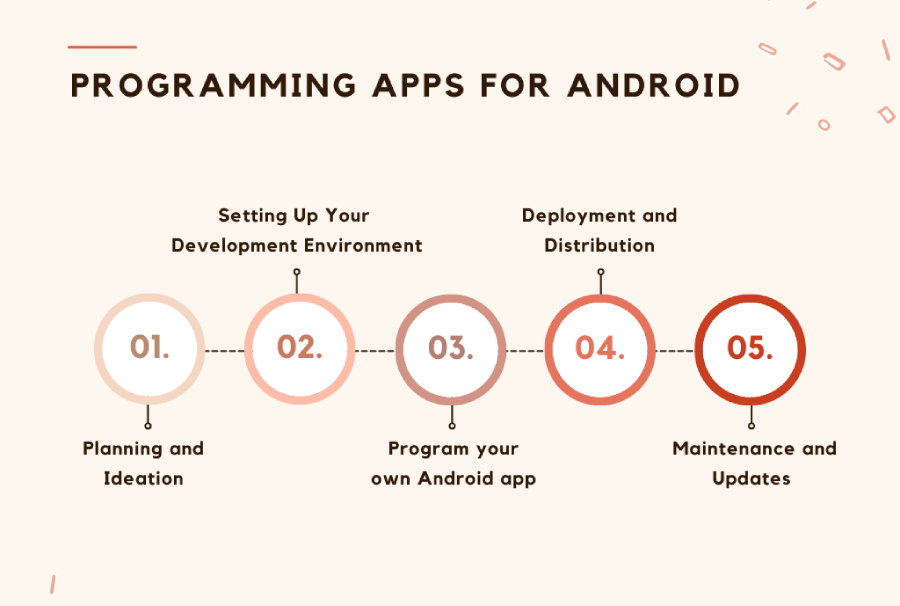
Der Entwicklungsprozess beim App-Programmieren für Android umfasst fünf Schlüsselphasen. Jede spielt eine entscheidende Rolle für den Erfolg Ihres Projekts.
Schritt 1: Planung und Ideenfindung
Definieren Sie zunächst, welches Problem Ihre Android-App lösen soll und wer Ihre Zielgruppe ist. Diese Aufgabe hilft Ihnen dabei, die App auf spezifische Anforderungen zuzuschneiden, da Sie nun einen Leitfaden für den Entwicklungsprozess haben.
Als nächstes, um Ihre eigene Android-App richtig zu programmieren, führen Sie gründliche Marktanalysen durch. Die Ergebnisse liefern wertvolle Einblicke, was für Ihre Zielgruppe gut funktioniert.
Sie müssen auch die Funktionen brainstormen, um eine Android-App erstellen zu lassen. Diese sollten die Benutzererfahrung verbessern und die zuvor identifizierten Anforderungen erfüllen.
Am Ende dieses Schrittes erstellen Sie Wireframes und Skizzen, um das Layout und den Benutzer-Fluss Ihrer App zu entwerfen. Diese Tools bieten einen klaren Plan für die Entwicklungsphase beim Android-App-Programmieren.
Schritt 2: Einrichten Ihrer Entwicklungsumgebung
Sie benötigen eine ideale Umgebung zum Programmieren einer App mit Android. Hier erfahren Sie, was Sie tun müssen:
Herunterladen und Installieren
Als offizielle IDE für die Android-Programmierung ist Android Studio das beste Werkzeug in diesem Schritt. Dieses Tool bietet Code-Editoren, Layout-Editoren und sogar Debugging-Tools, die Ihnen die Entwicklung von Android-Apps erleichtern. Denken Sie daran, die die neueste Version herunterzuladen, um auf alle erweiterten Funktionen zugreifen zu können. ,
Wählen Sie dann die Programmiersprache aus, mit der Sie arbeiten möchten. Das Programmieren einer Kotlin-App unterscheidet sich vom Programmieren einer App mit Java. Sie müssen auch Ihre Programmierkenntnisse berücksichtigen, um die beste Lösung zu finden.
Am besten laden Sie das Java Development Kit (JDK) herunter.. Dieses Paket enthält alle Bibliotheken und Tools, die für den Entwicklungsprozess benötigt werden.
Neues Projekt erstellen
Öffnen Sie nun das heruntergeladene und installierte Android Studio. Wählen Sie dann „Neues Android Studio-Projekt starten“.
Projekt Configuration
Arbeiten Sie nach dem Erstellen des Projekts an diesen Abschnitten:
- Projektname und Speicherort: Wählen Sie den Projektnamen und den Speicherort auf Ihrem Computer.
- Zielkompatibilität: Wählen Sie hier die Android-Versionen und Geräte aus, die Ihre App unterstützen soll.
- Projekttyp: „Leere Aktivität“ ist die häufigste Wahl für die Erstellung einfacher Apps.
Schritt 3: Programmieren Sie Ihre eigene Android-App
Dieser Schritt erfordert ein tiefes Verständnis der App-Struktur, der Benutzeroberfläche (UI), der Codierung, Funktionalität und des Testens.
App-Struktur in der Android-App-Programmierung
Die Android-Programmierung umfasst mehrere Schlüsselkomponenten, wie zum Beispiel:
- Aktivitäten: Diese Komponenten bieten Bildschirme, die Benutzer verwenden können, um zu interagieren und bestimmte Aufgaben auszuführen. Die gebräuchlichsten Aktivitäten sind Basis-, Leer-, untere Navigations-, Vollbild- und Google Maps-Aktivitäten.
- Layouts: Sie benötigen Layouts, um die visuelle Struktur der UI-Elemente für jede Aktivität zu definieren. Es gibt verschiedene Layouttypen, wie Frame-, Relative-, Listen-, Grid-, Tabellen- und Lineare Layouts. Jeder bietet unterschiedliche Möglichkeiten, Elemente anzuordnen und die Benutzerfreundlichkeit Ihrer Android-App zu beeinflussen.
- Ansichten (Views): Diese UI-Komponenten bilden die Benutzeroberfläche der App. Dazu gehören Elemente wie Bilder, Schaltflächen, Textfelder und vieles mehr. Sie können View Groups, eine Unterklasse von Views, verwenden, um UI-Komponenten besser zu verwalten.
Gestaltung der Benutzeroberfläche (UI)
Android Studio unterstützt Sie beim Entwerfen der Benutzeroberfläche, um eine einfache Android-App zu programmieren. Es bietet ein Drag-and-Drop-Layout, bei dem das Programm den Code automatisch in Java schreibt.
Beachten Sie beim Programmieren einer Android-App die Designprinzipien. Der Schlüssel zum Erfolg liegt in der Entwicklung optisch ansprechender und benutzerfreundlicher Oberflächen. Stellen Sie einfach Ihre Zielgruppe in den Mittelpunkt der Planung, und die Endprodukte werden Sie begeistern.
Codierung Funktionalität
Das Programmieren einer App mit Java oder Kotlin bedeutet, dass Sie diese Programmiersprache verwenden, um das Verhalten Ihrer Anwendung zu definieren. Die Codierung Aufgabe ist kompliziert, da Sie sich um Datenverarbeitung, Zugriff auf Gerätefunktionen und Benutzerinteraktionen kümmern müssen.
Ohne Programmierkenntnisse werden Sie an diesem Schritt scheitern. Aber keine Sorge! Viele Unternehmen sind sich ihrer Programmierfähigkeiten nicht sicher. Daher arbeiten sie mit einer App-Entwicklungsagentur zusammen, um diese knifflige Aufgabe zu bewältigen. Als erfahrene App-Entwicklungsagentur in der Schweizbietet STS Software GmbH erstklassige Dienstleistungen, um einfache Android-Apps für Ihre spezifischen Bedürfnisse zu erstellen. Arbeiten Sie mit uns zusammen, um den Unterschied zu erleben!
Testen und Debuggen
Tests sind entscheidend beim App-Programmieren für Android. Wenn Sie Android Studio verwenden, hier ist, was Sie für den Test tun müssen:
- Installieren Sie Android Debug Bridge (ADB) auf Ihrem Android-Telefon.
- Verbinden Sie Ihr Telefon über Bluetooth mit Ihrem Computer. Alternativ können Sie auch ein Micro-USB- oder USB-C-Kabel verwenden.
- Wählen Sie Ihr Telefon im Android Studio als Zielgerät aus.
- Klicken Sie auf „Play“, um den Test zu starten.
- Suchen Sie nach Fehlern (Bugs) und beheben Sie diese in den Android Studio-Einstellungen.
Schritt 4: Bereitstellung und Veröffentlichung
In diesem Schritt bereiten Sie Ihre App für die Veröffentlichung vor. Damit Nutzer Ihre App finden können, müssen Sie sie im Google Play Store bereitstellen. Der Bereitstellungsprozess läuft wie folgt ab:
- Prüfen Sie die Richtlinien des Google Play Store in Bezug auf App-Größe, Datenschutzbestimmungen, Screenshots und andere Anforderungen. Dieser Schritt stellt sicher, dass Ihre programmierte App den Richtlinien des Google Play Store entspricht. Mehr erfahren Sie im Developer Policy Center .
- Erstellen Sie ein Entwicklerkonto, öffnen Sie die Google Play Console und laden Sie Ihre Android-App zum Vertrieb in den Store hoch. Für die einmalige Registrierung fallen Kosten von 25 USD an.
- Nutzen Sie Strategien zur App Store Optimierung (ASO), um die Auffindbarkeit Ihrer App in den Suchergebnissen zu maximieren. Ihre Zielgruppe kann die richtigen Apps für ihre Bedürfnisse mithilfe von Keywords oder optimierten Listings finden. Konzentrieren Sie sich bei der Planung der App-Veröffentlichung daher auf diese Punkte.
Schritt 5: Wartung und Updates
Auch wenn Ihre App veröffentlicht ist, müssen Sie sie regelmäßig warten und aktualisieren. Die Wartung umfasst folgende Schritte:
- Überwachung der App-Performance: Überprüfen Sie Nutzerbewertungen, App-Downloads und Nutzungsstatistiken, um Optimierungspotenziale zu identifizieren.
- Fehlerbehebung: Es kann vorkommen, dass Ihre App Fehler (Bugs) enthält. Beheben Sie daher alle Probleme und Fehler, die Nutzer melden, um die optimale Leistung der App zu gewährleisten.
- App-Updates: Ihr Unternehmen wächst möglicherweise und die Anforderungen an die App ändern sich. Aktualisieren Sie Ihre App daher regelmäßig und fügen Sie neue Funktionen hinzu, um sich an die Veränderungen anzupassen.
Technologie entwickelt sich ständig weiter. Um wettbewerbsfähig zu bleiben, sollten Sie fortschrittliche Lösungen für die Programmierung von Android-Apps in Betracht ziehen. Die STS Software GmbH kennt die Spielregeln. Deshalb setzen wir auf Künstliche Intelligenz (KI), Maschinelles Lernen (ML) und Cloud-Technologien, um Ihnen das Beste zu bieten.
Zusätzliche Aspekte beim Programmieren einer Android-App
Neben den fünf oben genannten Schritten sollten Sie Versionskontrollsysteme, APIs (Application Programming Interfaces) und Sicherheitsmaßnahmen berücksichtigen.
- Versionskontrollsysteme: Diese Systeme helfen Ihnen, Codeänderungen und die Zusammenarbeit im Team zu verwalten. Ziehen Sie für diese Aufgabe Plattformen wie GitHub in Betracht. Versionskontrollsysteme reduzieren das Fehlerrisiko, ermöglichen Teammitgliedern die Projektbeteiligung von überall und helfen bei der Datenwiederherstellung im Falle von Problemen.
- APIs (Application Programming Interfaces): APIs ermöglichen die Datenübertragung zwischen App-Komponenten. Sie verwenden sie auch für den Zugriff auf Gerätefunktionen wie GPS, Kamera, Taschenlampe und Mikrofon.
- Sicherheit: Befolgen Sie beim Programmieren für Android die besten Sicherheits-Praktiken, um Ihre Privatsphäre und Benutzerdaten zu schützen.
STS Software GmbH zeichnet sich durch ein hervorragendes Management von Codeänderungen, die Entwicklung robuster APIs und erstklassige Sicherheitsmaßnahmen aus. Wählen Sie uns und beginnen Sie noch heute mit Zuversicht mit der Android-Entwicklung!
Programmieren Sie Ihre eigene Android-App mit der STS Software GmbH
Sie müssen Ihre Android-App nicht selbst programmieren, wenn Sie uns an Ihrer Seite haben. Durch die Partnerschaft mit uns profitieren Sie von folgenden Vorteilen:
- Wir sind das führende Unternehmen für App-Entwicklung in der Schweiz mit mehr als 12 Jahren Erfahrung.
- Unsere individuellen Android-Entwicklungsdienste, von der Programmierung einfacher Android-Apps bis hin zu Unternehmensanwendungen.
- Wir beherrschen die Programmierung von Apps mit Java und Kotlin.
- Unsere Lösungen können unterschiedliche Anforderungen erfüllen, da wir uns auf native Apps, hybride Apps und Web-Apps spezialisiert haben.
- Unser Team nutzt moderne Technologien wie KI, ML und Cloud-basierte Lösungen, um die Funktionalität Ihrer App zu maximieren.
- Wir gewährleisten die App-Sicherheit durch Geheimhaltungsvereinbarungen (NDA) und ISO 9001-2017.
Lassen Sie Ihre Android-App programmieren: Sehen Sie sich unsere realen Projekte an
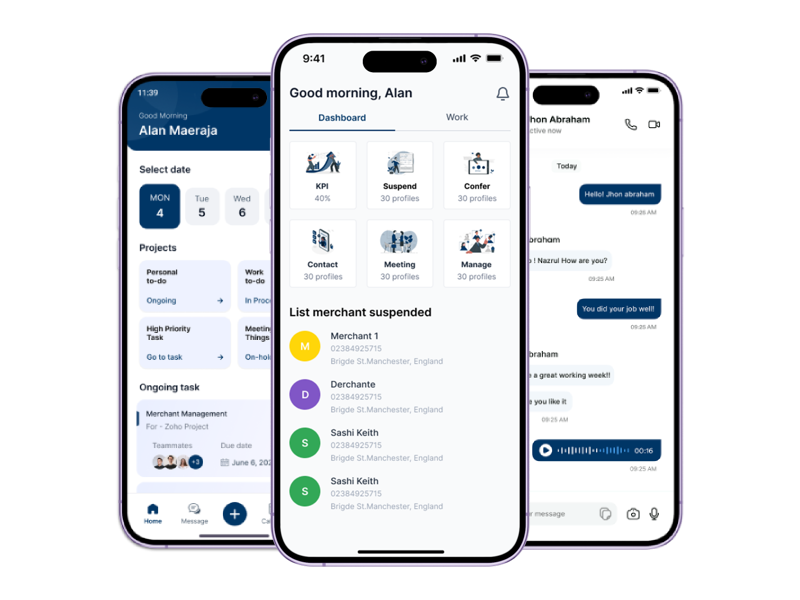
Sind sie noch unschlüssig? Dann werfen Sie einen Blick auf unsere realen Projekte, um zu sehen, wie wir unseren Kunden zum Erfolg bei ihren Android-Entwicklungsprojekten verholfen haben.
Seamless Digital Distribution
Für die STS Software GmbH haben wir die „Seamless Digital Distribution“ entwickelt, um schnelle Verkaufsprozesse zu gewährleisten. Das Produkt umfasst Zahlungsoptionen und Ladegeräte für Mobiltelefone. Der Vertrieb erfolgt über verschiedene Kanäle, um die Benutzerinteraktion und die Geschäfts-Effizienz zu verbessern.
Chiliplay
Für Chiliplay haben wir eine funktionsreiche App entwickelt. Die Funktionen umfassen Push-Benachrichtigungen, eine Bestenliste, einen Newsreader und einen Barcode-Scanner, um die Benutzerinteraktion zu verbessern. Darüber hinaus bieten wir unseren Kunden ein Festpreismodell mit kontinuierlicher Unterstützung.
Fazit
Jetzt können Sie Ihre eigene Android-App mit der umfassenden Anleitung oben erstellen. Der Prozess stellt einige Herausforderungen, aber Sie können es schaffen und hervorragende Belohnungen erzielen.
Wenn Sie sich nicht sicher sind, können Sie Ihre App-Entwicklung an Experten wie die STS Software GmbH auslagern. Kontaktieren Sie uns für ein kostenloses Angebot und machen Sie den ersten Schritt, um Android-Apps erfolgreich zu programmieren!
Let’s Talk
Beginnen Sie die Konversation mit unseren Analysten und Entwicklern. Zusammen erheben wir die Bedürfnisse und skizzieren die neue Lösung
Gemeinsam mit unseren Entwicklern und Analytikern beginnen wir mit der Diskussion und Analyse der Kundenbedürfnisse und skizzieren die Grundzüge.
- [email protected]
- Leberngasse 19, 4600 Olten, Switzerland
- +41 62 503 70 50
© 2022 STS Software GmbH. All rights reserved.
Gemeinsam mit unseren Entwicklern und Analytikern beginnen wir mit der Diskussion und Analyse der Kundenbedürfnisse und skizzieren die Grundzüge.
FOLLOW
- [email protected]
- Industriestrasses 78 , 4600 Olten, Switzerland
- +41 62 503 70 50
BLOG
Abonnieren Sie uns
Melden Sie sich an, um die neuesten Informationen und tolle Angebote direkt in Ihren Posteingang zu erhalten.
© 2022 STS Software GmbH. All rights reserved.